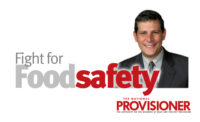Human illnesses caused by Salmonella has been an issue that the Centers for Disease Control and Prevention (CDC) and USDA’s FSIS have been grappling with for many years. Indeed, CDC estimates that, each year, Salmonella is responsible for approximately 1.35 million human illnesses and 26,500 hospitalizations in the US. In turn, FSIS believes that the vast majority of these illnesses are caused by the handling and consumption of foods, such as poultry, that are contaminated with the bacteria.
In response, FSIS has spent years debating and then unveiling regulatory proposals designed to lower the incidence of Salmonella contamination in certain foods, with a major focus on poultry products. In the most recent pronouncement by the agency, FSIS stated its intention to declare any raw stuffed and breaded poultry product containing Salmonella to be adulterated. The net effect, the agency hopes, is to begin to lower the numbers of annual Salmonella infections caused by contaminated foods.
With all that said, the dilemma the agency faces is that Salmonella contamination is a complex concept that is not easily solved by simply declaring Salmonella to be an adulterant in a single class of products. If we are being honest with ourselves, we are forced to acknowledge that Salmonella can exist in a very wide and diverse variety of products, including foods, to name just a few, such as produce, peanut butter, onion powder, infant formula, tahini, yeast extract, salami (antipasto), fresh raw fish, shrimp, hamburger buns, potato chips, bagged salads, dry cookie mixes, baking flours, dehydrated vegetables, dips, ham, hummus, ground beef, raw eggs, nuts (all varieties), chocolate candy bunnies, herbal extracts, peaches, mushrooms, cheese dip, basil seed, tarragon leaves, raw cookie dough, Twinkies, snack mixes, pork skins, express mac & cheese, non-fat dry milk, seaweed, chocolate covered pretzels, imitation bacon bits, whole hogs for BBQ’s, peppers, cheese, half and half whipping cream, kale, iced tea, banana cream pie filling, raw organic shakes, nut butters, steel cut oats, frozen ravioli, apples, avocados, deli sandwiches, coriander powder, salad dressing, hundreds of additional foods I left out, humans, a wide variety of household pets, and … deep breath … raw poultry.
Given the incredible prevalence of Salmonella in the environment and in foods generally, I am not convinced that FSIS’ recent pronouncement regarding Salmonella in only certain raw breaded and stuffed poultry will have the wide-ranging impact the agency is hoping for. The fact remains that, when it comes to humans, food facilities, and food products, Salmonella can be found everywhere, and is likely here to stay.
To add to the frustration, in those instances where Salmonella infections are preventable, such as when the bacteria is present in raw products that are sold with safe handling warnings or validated cooking instructions, consumers are doing an especially poor job. When justifying its raw breaded poultry position, FSIS often speaks of high school kids coming home and undercooking those raw products in the microwave “because they appear to be cooked.” While the agency’s comments are well-intentioned, the fact remains that the consumer, not the processor, is the one acting in a way that puts their safety at risk. If a raw poultry product has validated cooking instructions that will render the product safe, then why should the processor be held in all circumstances to account?
Instead of placing the onus on the processor only, the agency should consider the use of its resources to also EDUCATE consumers to FOLLOW the federally mandated save handling warnings (and, when present, the validated cooking instructions) which are placed on the products to ensure public health.
Indeed, when it comes to the handling of raw poultry, raw eggs, raw flour, raw vegetables, raw dough, or any of the other raw products discussed above, consumers tend to do a less than stellar job. And, if we ask ourselves why, the answer is likely that we are doing a less than stellar job of educating consumers properly. Indeed, we should consider whether, rather than only teaching consumers that they can consider certain raw poultry products to be sterile, we should also consider how we can continue to reinforce the lifelong lessons we were all taught that ALL raw poultry products need to be handled and cooked properly, regardless of whether they are breaded or not.





Report Abusive Comment